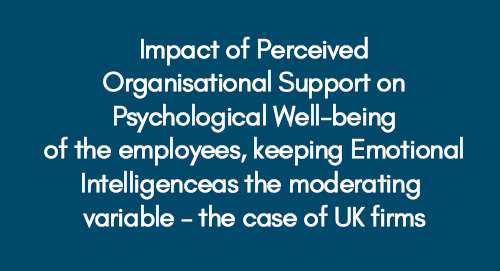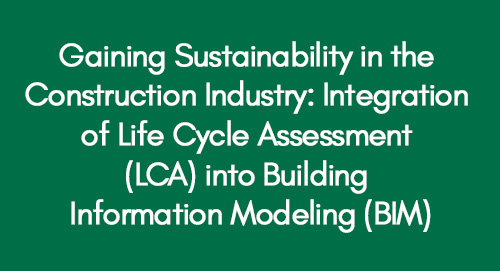
International Business – Mattel
January 15, 2021
Impact of Perceived Organisational Support on Psychological Well-being of the Employees, Keeping Emotional Intelligence as the Moderating Variable – The Case of UK Firms
January 15, 2021Exploring how using Life Cycle Assessment (LCA) with Building Information Modeling (BIM) helps construction become more eco-friendly. Discovering ways to make buildings greener by combining two important methods in construction. The concept of sustainable development has increasingly amassed attention globally.
1.0. Introduction
A report that was published by the World Commission on Environment and Development (WCED), called for an approach that merges construction projects and the environment to sustainably meet the needs of the present without jeopardising the capability of prospective generations to address their own needs (Ortiz et al. 2009).
Efficient Construction Analysis-Case of BIM
The United Nations (2015) also maintains that the primary challenge of the 21st century would be sustainable development. Thus, implementing sustainable development projects is key to protecting the “already depleted” environment while meeting and securing the future of posterity.
The discourse on economic, social, and environmental elements of sustainable development is currently focusing on the construction sector; an internationally emerging industry, and a relatively active enterprise in both developing and developed countries (Ortiz et al. 2009). For instance, according to the European Commission (2017), around 14 million people are directly employed by the construction industry and it is Europe’s leading industrial employer, representing 7 per cent of the entire employment and 30 per cent of sectoral employment in Europe. Besides, more than 900 billion euros was spent on construction in 2013, representing 10 per cent of the region’s gross domestic product (GDP). However, environmentally, the construction industry has been implicated in high-energy usage, greenhouse gas emissions, solid waste products and other forms of environmental pollution (Ortiz et al. 2009). Given these facts, there is a need to incorporate innovative and sustainable solutions into development projects to minimise the environmental depletion caused by the construction industry.
Exploring BIM Design Coordination
Building Information Modeling (BIM)and sustainable construction comprise the two most trending and growing concepts in the construction sector. BIM is a new technology used in construction design in which a digital image of the building activity is used to aid in the exchange of data in digital form (Porwal & Hewage 2013). It is an approach used to manage construction design and project information in digital layout during the entire project’s life cycle.
Life cycle assessment (henceforth referred to here as LCA) is also another approach that is used to make informed decisions during the initial construction design phases. In the construction project context, LCA is a tool used for critical assessment of the environmental implications arising from buildings throughout their life cycle (Han et al. 2013). LCA assessment incorporates environmental implications from building material acquisition to construction, building use and ultimate demolition. It takes into consideration all the project costs, from ownership to the disposing of a structure. However, even though the application of LCA in sustainable construction projects has been widely implemented, the model has often been used as a ‘stand-alone’ tool. The application of LCA as an independent system presents a barrier to the functional inclusion of other possible approaches to implementing sustainable construction. To overcome this problem, this study proposes the integration of life cycle assessment (LCA) into BMI particularly about decision-making to support the course for sustainability within the construction industry.
The following text comprises the problem statement of the study.
1.1. Research Problem Statement
Despite the booming growth in the construction enterprise, the sector faces new challenges. Society is demanding a reduction in energy and resource consumption, and the execution of sustainable buildings. There is a fundamental need for a shift in the construction industry's focus from a cost-based approach to a value-based one (Ortiz et al. 2009). The LCA has previously been applied in development projects to improve the sustainability of buildings and to mitigate environmental damage caused by the construction industry. However, the LCA has only been used as a lone technique for addressing sustainability challenges and this limits the incorporation of other methods that could significantly contribute to sustainability in the construction industry. Given the stated challenge, the author of this project believes that the integration of Life Cycle Assessment (LCA), with BIM, could go a long way to foster decision-making processes involving the mitigation of buildings’ environmental damage and realising sustainable design.
1.2. Research Aims and Objectives
- To investigate the nexus between BIM strategies and environmental data contained in the LCA databases.
- To examine the construction project phases which can have the most impact on realising sustainable construction
- To evaluate the properties of both LCA and BIM approaches and to analyse at which phases both methodologies can be optimally merged.
2.0. Literature Review
The following texts are related to the literature review of the study.
2.1. The Concept of Sustainability in the Construction Sector: The LCA Model
According to Hopwood et al. (2005), ‘sustainable development’ can be defined as improving the quality of life and therefore allowing individuals to inhabit a safe and healthy environment while enhancing the economic, social and environmental well-being of both the present and succeeding generations. Within the context of construction projects, the terms sustainable development, high performance, green structures, and sustainable construction are usually used interchangeably (Kibert 2008). However the phrase ‘sustainable construction ’in most cases extensively deals with the economic, ecological and social element of a constructed building in the context of the community. With the increasing consciousness of sustainability issues, several tools have been made to evaluate sustainability from various perspectives. One of these tools is the life cycle assessment model (LCA).
Improving Resilience and Sustainability in Construction Projects – Case of BIM and LCA
Ortiz et al. (2009) contend that the development of the LCA model has been relatively slower in the construction sector than in other industries, even though it was first actualised in the early 90s. Whereas the guidelines given in the different LCA benchmarks apply to industrialised operations, Arena & De Rosa (2003) argue they do not fit quite well in building projects due to a variety of special attributes. For example, the same authors believe that the long life cycle of builds and the fact that each product is inimitable significantly affects the applicability of LCA in the construction field. On the contrary, the construction industry is increasingly applying the LCA approach to decision-making processes in the quest to optimise the entire construction process (Antón & Díaz 2014).
Apart from the LCA model, other approaches can be used to assess the environmental effects of buildings, for instance, Life Cycle Energy Analysis (also known as LCEA) and Life Cycle Cost Analysis (also called LCCA). Contrary to LCA, the LCEA concentrates more on the energy consumption of a construction during its entire life cycle, including the operating and demolition energy, and the total energy used in the building is what is called the life cycle energy (Cabeza et al. 2014). Project engineers who utilise the LCEA method can easily determine the phases that consume the most energy, thus enabling them to make more appropriate choices on the best energy-efficient materials to use. The LCEA method can also measure greenhouse gas emitted through the main energy of a building by multiplying it by a certain factor. However, the LCA method offers more accurate and reliable outcomes (Ramesh et al. 2010), because with this approach, the building’s environmental impact is analysed from the start of the assessment.
2.1.1. Benefits of LCA as a Decision-Making Guide
As mentioned in the previous section, LCA is highly used to guide the decision-making process in the early phases of a construction project phases. It can help in material selection, offer support when comparing different options, guide the organisation of the procedure for residue disposal and help in the creation of the construction schedule. It also gives guidance on how to enhance environmental performance in the entire life cycle of a building. The LCA also makes it easy to analyse the environmental performance of various constructions and to gain knowledge from this experience (Ortiz et al. 2009). Besides, a broad scope of environmental elements can be assessed in addition to energy usage. The LCA has been found to help in cost reduction because it minimises environmental costs thereby contributing to a reduction in the consumption of both energy and resources (Ortiz et al. 2009). LCA helps in increasing social consciousness of environmental effects. Therefore all the construction project stakeholders including the community have to be aware of the implications of environmental impacts.
2.1.2. The Challenges of Using LCA Independently
One of the primary limitations of using the LCA tool is that one has to be a data entry expert to run the software, unlike BIM which is user-friendly. Also, LCA has been know to consume a lot of time. Furthermore, in some cases, there may be insufficient data or the available information may have lost value. These challenges could result in assumptions that might render the LCA assessment inaccurate (Han et al. 2013). There is even no benchmarking or a universal methodology on how to rank LCA performance. Even though ISO requirements of LCA give a basic framework, it does not provide a systematic methodology.
A building usually comprises a variegated class of products, and each of those products has its unique features, life span and ecological effects. This combined with the uncertainty about the premise’s future makes it very almost impossible to conduct an LCA evaluation of the entire building as a single entity. Another problem is the misuse of LCA due to its implementation in the late phases of the project.
All the challenges highlighted above are associated with the complexity and costs of using the LCA tool independently. Thus the LCA tool needs advanced development if it has to be successfully applied as a decision-making support guide. In a nutshell, the LCA approach has several limitations which could be solved by optimising it with BIM.
2.2. Optimisation of LCA Using BIM
According to Antón & Díaz (2014), sustainable development in the construction sector largely depends on realising the minimal ecological impact and at the same time spurring both economic and social progress. Presently, the sector is not quite efficient owing to a lack of sufficient collaboration efforts and blatant waste of resources. Hence there is a need for change as far as these issues are concerned. Optimised design can be achievable through the integration of innovative tools such as BIM and LCA. The advantage of this approach is that it directs attention, efforts and resources to the initial design stages; this means an increased ability to impact the project.
The BIM has been identified as a significant contributor to building sustainability because it can foster the execution of an integrated design. The tool has an enhanced capacity for data management and fosters cooperation of various stakeholders engaged in the construction project from the initial design stages going forward. This gives a snapshot of the task, and the construction sector can, therefore, perform more effectively (Antón & Díaz 2014).
One of the limitations of using LCA as a lone tool is, in fact, the manual re-entry of the project information into the tool. This is one of the major challenges that needs to be addressed (Antón & Díaz 2014). According to Antón & (Díaz 2014), successful optimisation of LCA using BIM, would go a long way to resolving the manual re-entry of issues of data because it is believed that the LCA models could easily access BIM data. The BIM tools have data on the project cost and can, therefore, help in cutting down on project cost in sustainable construction design because they give the essential data and evaluate it. It is thought that the BIM’s ability to improve construction sustainability could be achieved via integration with the LCA model. BIM has promising prospects in terms of realising sustainable design, however, presently this potential has not been fully tapped. Ortiz et al. (2009) attribute the lack of interoperability as the main hindrance to the realisation of BIM’s full potential. The potential of BIM as far as sustainability is concerned could be improved by synergising with LCA.
Use of Building Information Modeling (BIM) in Construction Industry
Antón & Díaz (2014) provide two approaches to integrating LCA with BIM. According to these authors, the first strategy involves mining the project data directly from the BIM too and utilising it to carry out an LCA analysis of a building project throughout its life cycle. Since the BIM system is employed as the main data source, this avoids the cumbersome data re-entry which is often done manually. The other suggested technique is based on carrying out LCA analysis of premises that have been developed using the BIM tool. The advantage of this approach is that it can be used to carry out a comparative analysis between projects that have been completed using the LCA-BIM integrated approach and those that have been done using only BIM.
The primary goal of this study is to propose a methodology for integrating LCA into BIM in construction projects to ensure sustainability in the construction industry.
3.0. Methodology
The aim is to identify the relationship between BIM and LCA about environmental analysis. The project also aims to offer the theoretical basis for optimised construction design and offers recommendations on which phase of LCA-BIM integration produces optimal results. Data collection will be carried out by way of qualitative technique and the research methodology that will be in this work will include a survey of relevant literature, comparative studies, inductive reasoning and interviews.
3.1. Literature Review
The data to be used in this work will mainly be collected through an extensive survey of the literature, in the quest to evaluate the current state of the LCA-BIM integration concept about sustainability. This will help in giving an understanding as well as defining the implications, driving factors and merits of LCA-BIM collaborative application, and also as pinpoint the barriers and constraints of the existing practices. The sources for the materials to use in the literature survey include several research articles, books, conference proceedings, scientific papers, scholarly publications, handbooks, and websites of various construction firms and regulatory agencies. The author of this study will ensure that the information used is objective and of the highest integrity.
3.2. Comparative Analysis
Through the utilization of comparative studies, various interrelated objective elements will be compared, so that objective conclusions, about merits and demerits, can be drawn. For example, this project will comparatively analyse the conventional and the LCA-BIM integration methods, to ensure that concerns relating to existing practices are pointed.
3.3. Inductive Reasoning
Ketokivi & Mantere (2010) perceive inductive reasoning as a basic element of human intelligence. It starts with certain observations and actions, which then result in the identification of particular patterns from which certain hypotheses can be drawn and tested, which would ultimately lead to a general conclusion. In this work, inductive reasoning will be utilised to reason specific design decision-making aspects, which result in the detection of patterns conducive to collaboration during the initial design phase.
3.4. Interviews
Interviews comprise one of the most popular techniques of qualitative data gathering. Interviews will also be utilised in this project to find out about the set of knowledge and perspectives of different people, and to have a deeper understanding of some of the interoperability issues between LCA-BIM sustainability analysis and environmental performance assessment.
3.5. Expected Research Results
The author of this project that at the end of the project, concrete recommendations will be provided on the best methodology of integrating LCA into BIM in the context of construction projects. Besides, it is anticipated the project phase at which maximum LCA-BIM can be achieved in a construction project will be identified. Lastly, the findings of this project will be published in peer-reviewed journals.
Research Plan and Timeline
TASKS | Months | |||||||||||
1 | 2 | 3 | 4 | 5 | 6 | 7 | 8 | 9 | 10 | 11 | 12 | |
Research Proposal |
|
|
|
|
|
|
|
|
|
|
|
|
Literature Review |
|
|
|
|
|
|
|
|
|
|
|
|
Data collection |
|
|
|
|
|
|
|
|
|
|
|
|
Analysis |
|
|
|
|
|
|
|
|
|
|
|
|
Implement Findings |
|
|
|
|
|
|
|
|
|
|
|
|
Prepare Draft Report |
|
|
|
|
|
|
|
|
|
|
|
|
Complete Data Analysis |
|
|
|
|
|
|
|
|
|
|
|
|
Interpretation of the Findings |
|
|
|
|
|
|
|
|
|
|
|
|
Concluding and submitting the Research |
|
|
|
|
|
|
|
|
|
|
|
|
Bibliography
Antón, L.Á. & Díaz, J., 2014. Integration of LCA and BIM for Sustainable Construction. World Academy of Science, Engineering and Technology International Journal of Social, Education, Economics and Management Engineering, 8(5), pp.1356–1360.
Arena, A.P. & De Rosa, C., 2003. Life cycle assessment of energy and environmental implications of the implementation of conservation technologies in school buildings in Mendoza - Argentina. Building and Environment, 38(2).
Cabeza, L.F. et al., 2014. Life cycle assessment (LCA) and life cycle energy analysis (LCEA) of buildings and the building sector: A review. Renewable and Sustainable Energy Reviews, 29(2014), pp.394–416.
Han, G., Srebric, J. & Enache-Pommer, E., 2013. Variability of optimal solutions for building components based on comprehensive life cycle cost analysis. Energy and Buildings, 79, pp.223–231.
Hopwood, B., Mellor, M. & O’Brien, G., 2005. Sustainable development: Mapping different approaches. Sustainable Development, 13(1), pp.38–52.
Ketokivi, M. & Mantere, S., 2010. Two strategies for inductive reasoning in organizational research. Academy of Management Review, 35(2), pp.315–333.
Kibert, C.J., 2008. Sustainable construction : green building design and delivery,
Ortiz, O., Castells, F. & Sonnemann, G., 2009. Sustainability in the construction industry: A review of recent developments based on LCA. Construction and Building Materials, 23(1), pp.28–39.
Porwal, A. & Hewage, K.N., 2013. Building Information Modeling (BIM) partnering framework for public construction projects. Automation in Construction, 31, pp.204–214.
Ramesh, T., Prakash, R. & Shukla, K.K., 2010. Life cycle energy analysis of buildings: An overview. Energy and Buildings, 42(10), pp.1592–1600.
United Nations, 2015. United Nations Millennium Development Goals. United Nations.
Get 3+ Free Dissertation Topics within 24 hours?



























